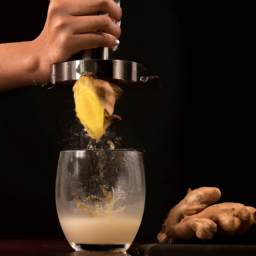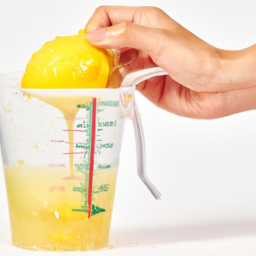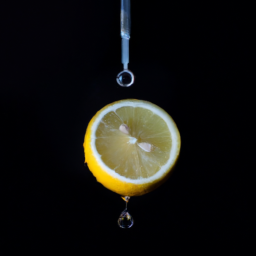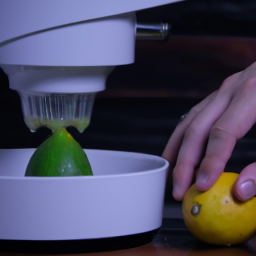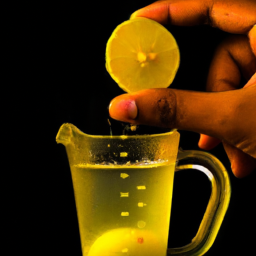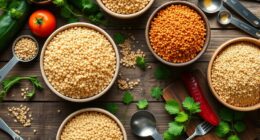As a dietitian, I am always searching for natural ways to improve my health and add flavor to my drinks and meals. Ginger root is a top choice because it has many health benefits and a unique taste. Juicing ginger root is a great way to incorporate its advantages into your diet, and it is easier than you may think.
Ginger root contains a compound called gingerol, which has anti-inflammatory and antioxidant properties. It has been shown to alleviate nausea, reduce muscle pain and soreness, lower blood sugar levels, and even improve brain function. Juicing ginger allows you to concentrate its nutrients and flavor, making it a potent addition to your wellness routine.
In this article, I will guide you through the process of juicing ginger root, from selecting the right piece of ginger to storing the juice for later use.
Key Takeaways
- Ginger root contains gingerol, which has anti-inflammatory and antioxidant properties, and offers various health benefits such as reducing muscle pain, lowering blood sugar levels, and aiding in digestion.
- Juicing ginger root is an easy way to incorporate its goodness into your diet, and can be done by blending with water and straining through cheesecloth or using a juicer. Ginger shots are also popular for health benefits.
- Organic ginger is recommended for better health benefits, as it is grown without synthetic pesticides and fertilizers and contains higher levels of bioactive compounds responsible for medicinal properties. Growing ginger is easy and requires minimal maintenance.
- Ginger juice can be stored in an airtight container in the refrigerator for up to 5 days or frozen in ice cube trays for up to 6 months, and can be a great addition to drinks, cooking, and salad dressings. Discard ginger juice immediately if signs of spoilage are noticed.
Benefits of Juicing Ginger
Juicing ginger not only adds a zesty kick to your morning juice, but it also boasts a plethora of health benefits. Ginger contains a compound called gingerol, which has anti-inflammatory and antioxidant properties. This makes it a powerful aid in fighting off diseases and boosting the immune system. Drinking a ginger shot or ginger tea can help ease nausea, reduce muscle pain and soreness, and even lower blood sugar levels.
Aside from its immune-boosting properties, ginger also aids in digestion by stimulating the production of digestive juices and enzymes. It can also help alleviate indigestion, bloating, and other gastrointestinal discomforts. Incorporating ginger into your daily diet can lead to improved overall health and well-being.
Now that we know about the benefits of juicing ginger, let’s dive into how to choose the right ginger root for juicing.
Choosing the Right Ginger Root
When selecting the perfect ingredient for your homemade wellness elixir, it’s important to examine the ginger rhizomes for signs of quality. Choose a ginger root that is smooth and firm to the touch, with a fresh, spicy aroma. The skin should be thin and papery, without any signs of mold or soft spots.
Freshness and ripeness are also important factors to consider when choosing ginger. Look for rhizomes that have recently been harvested, as older roots may have lost some of their potency. The ginger should also be ripe, with a bright yellow interior and a juicy texture.
When selecting ginger, it’s important to choose a root that is both fresh and ripe to ensure maximum flavor and health benefits.
Now that you have chosen the perfect ginger root, it’s time to move on to cleaning and preparing it for juicing.
Cleaning and Preparing the Ginger
To get your elixir started, you’ll want to clean and prepare the ginger. Proper washing is essential to remove any dirt or pesticide residue that may be present on the rhizome. You can use a vegetable brush to scrub the skin thoroughly under cold running water.
It’s also important to peel the ginger before juicing it. The skin can be tough and fibrous, and may affect the texture of your juice. Here are three tips for peeling ginger:
-
Use a spoon: One of the easiest ways to peel ginger is to use a spoon. Simply scrape the skin off with the edge of the spoon, using a gentle back-and-forth motion.
-
Use a vegetable peeler: If you prefer a more traditional approach, you can use a vegetable peeler to remove the skin. Hold the ginger firmly and gently run the peeler along the surface of the rhizome.
-
Use a knife: If you’re comfortable using a knife, you can peel the ginger with a sharp kitchen knife. Hold the ginger firmly and carefully slice off the skin in thin strips.
Once the ginger is cleaned and peeled, it’s time to move on to cutting it into smaller pieces for juicing.
Cutting the Ginger
After cleaning and peeling the ginger root, it’s essential to chop it into smaller pieces before juicing. Slicing techniques are crucial in preparing your ginger root for juicing. A sharp knife is essential in slicing the ginger root into small pieces. The size of the pieces should be small enough to fit into the juicer’s chute and not too large to cause clogging.
There are different ways to slice ginger root, depending on how you intend to use it. For juicing, the most common technique is to cut the ginger into thin slices. A mandoline can be used to achieve uniform slices. Alternatively, you can use a sharp knife to slice the ginger into thin pieces.
Once the ginger root is sliced into smaller pieces, it’s ready for juicing.
Preparing ginger for juicing requires equipment such as a sharp knife or a mandoline. Slicing the ginger into small pieces is crucial in ensuring that the juicer works efficiently and effectively.
In the next section, we’ll look at how to juice the ginger and the benefits of ginger juice.
Juicing the Ginger
Imagine you’re a mad scientist creating a potion, and the final step is feeding the machine with your perfectly sliced and diced ginger pieces to extract the elixir of life. This is the process of juicing ginger, and it can be done in various ways. One method is blending ginger with water and straining the mixture through a cheesecloth. This is a simple method that requires minimal equipment and produces a smooth, pulp-free juice. Another popular technique is using a juicer, which extracts the juice from the ginger root and separates it from the pulp.
Blending ginger is a quick and easy way to make ginger shots, which are concentrated doses of ginger juice. Ginger shots are popular for their health benefits, including reducing inflammation, relieving nausea, and boosting the immune system. The table below shows the nutritional information for one ounce of ginger juice, which is equivalent to one ginger shot. Once the ginger has been juiced, it can be stored in an airtight container in the refrigerator for up to five days. In the next section, I will discuss the best ways to store ginger juice to ensure its freshness and potency.
| Nutrient | Amount per 1 oz of Ginger Juice |
|---|---|
| Calories | 5 |
| Carbohydrates | 1g |
| Fiber | 0g |
| Protein | 0g |
| Fat | 0g |
| Vitamin C | 2% RDA |
| Iron | 1% RDA |
| Calcium | 0% RDA |
Blending and juicing ginger is a simple process that can be done in a few easy steps. The resulting juice can be used to make ginger shots or added to smoothies and other drinks for an extra kick of flavor and nutrition. Properly storing ginger juice is essential to maintaining its freshness and potency, so be sure to follow the guidelines in the next section.
Storing the Ginger Juice
Ensuring that your ginger elixir stays fresh and potent is crucial for maximizing its health benefits, and there are a few simple tips for storing it properly.
First, it’s important to note that ginger juice can spoil quickly, so it’s best to consume it within a few days of juicing. To prolong its shelf life, consider the following tips:
- Store the ginger juice in an airtight container, such as a mason jar or a glass bottle with a tight-fitting lid, to prevent air exposure and contamination.
- Keep the ginger juice refrigerated at all times to slow down bacterial growth and maintain freshness.
If you want to freeze ginger juice for later use, pour it into ice cube trays and freeze. Once frozen, you can transfer the ginger cubes into a resealable plastic bag and keep them in the freezer for up to six months.
If you notice any signs of spoilage, such as a foul odor or mold growth, discard the ginger juice immediately to avoid any health risks.
By following these simple tips, you can ensure that your ginger juice stays fresh and potent for longer, allowing you to enjoy its numerous health benefits.
Now that you know how to store ginger juice properly, let’s move on to the next step: adding ginger juice to your drinks.
Adding Ginger Juice to Your Drinks
Now that we’ve learned how to store ginger juice, let’s talk about how to use it. Ginger juice is a great addition to any drink, whether it’s a smoothie, tea, or cocktail. It adds a spicy kick and a plethora of health benefits for digestion.
One of my favorite ways to use ginger juice is to spice up cocktails. A little bit of ginger juice can add a unique flavor profile to any cocktail and can even replace traditional cocktail mixers like simple syrup. Additionally, ginger has been shown to aid in digestion, making it a great addition to any drink after a big meal.
So, next time you’re mixing up a drink, try adding some ginger juice for an added boost of flavor and health benefits.
As we’ve seen, adding ginger juice to your drinks can be a game-changer. But don’t stop there. Ginger juice can also be used in your recipes. Let’s explore how to incorporate ginger juice in your cooking for even more delicious and healthy meals.
Using Ginger Juice in Your Recipes
I love using ginger juice in my cooking to add a spicy kick to my dishes. One of my favorite ways to incorporate ginger juice is by adding it to my homemade salad dressings. It pairs well with citrus flavors and adds a unique depth of flavor to my salads.
Another way I use ginger juice is in my marinades for meat and fish. The enzymes in ginger help to tenderize the meat and add a delicious flavor to my dishes.
Add It to Your Salad Dressings for a Spicy Kick
To spice up your salads, you can simply mix ginger juice with olive oil and vinegar for a zesty dressing that only takes a minute to make. Ginger adds a spicy kick to your salads that will leave your taste buds tingling. It’s also a great way to add some flavor to a boring salad and make it more exciting.
Ginger is known for its anti-inflammatory properties, making it a great addition to any healthy diet. Studies have shown that ginger can help reduce muscle pain and soreness, making it a great ingredient to add to your post-workout salad. One of my favorite ways to use ginger in a salad dressing is to make a ginger vinaigrette.
Simply mix ginger juice, olive oil, vinegar, and a pinch of salt and pepper. This dressing is perfect for a spicy salad with arugula, mixed greens, and cherry tomatoes. Use it in your marinades for meat and fish to add a zesty flavor that will make your taste buds dance.
So, add it to your salad dressings for a spicy kick!
Use It in Your Marinades for Meat and Fish
Looking to add some zesty flavor to your meat or fish? Try using ginger juice in your marinades for an extra kick that will leave your taste buds dancing. Ginger has anti-inflammatory properties that make it a great addition to any dish. Incorporating ginger juice in your marinades not only adds flavor but also tenderizes the meat, making it easier to digest.
To make a ginger marinade, start by juicing a ginger root and mixing it with your favorite herbs and spices. Use the table below for guidance on how much ginger juice to use for different types of meat and fish. You can also incorporate ginger juice into stir fries for added flavor and health benefits. Get creative with your cooking and explore the many ways you can use ginger juice to enhance your dishes.
| Type of Meat/Fish | Amount of Ginger Juice |
|---|---|
| Chicken | 1-2 tablespoons |
| Beef | 2-3 tablespoons |
| Fish | 1-2 tablespoons |
| Shrimp | 1-2 tablespoons |
Now that you know how to incorporate ginger juice into your marinades, let’s move on to some tips on how to juice a ginger root.
Tips for Juicing Ginger
When it comes to juicing ginger, I always make sure to use organic ginger for better health benefits. This ensures that I’m not consuming any harmful pesticides or chemicals.
Additionally, I like to experiment with different ginger varieties to add a unique flavor to my juices and recipes. It’s amazing to see how different types of ginger can affect the taste and aroma of a juice.
Use Organic Ginger for Better Health Benefits
Using organic ginger is like choosing a high-quality paintbrush – it may cost more, but the end result is worth it. When it comes to ginger juice, using organic ginger can provide more health benefits compared to conventional ginger. Here are three reasons why:
-
Organic ginger is grown without the use of synthetic pesticides and fertilizers, which means that you’re not consuming harmful chemicals along with the ginger juice. This is especially important since ginger is known to have powerful anti-inflammatory and antioxidant properties that can help boost your immune system and fight off diseases.
-
Organic ginger contains higher levels of bioactive compounds such as gingerols, shogaols, and zingerones, which are responsible for its medicinal properties. These compounds are more abundant in organic ginger since it’s allowed to grow at a slower pace without the use of growth hormones and other chemical agents.
-
By choosing organic ginger, you’re supporting sustainable farming practices that are better for the environment. Organic farming reduces pollution, conserves water, and promotes biodiversity, which means that you’re not only benefiting your health but also the planet.
If you want to maximize the health benefits of ginger juice, using organic ginger is the way to go. However, keep in mind that ginger comes in different varieties, and each one has its unique flavor and aroma.
In the next section, we’ll explore how to experiment with different ginger varieties to find the one that suits your taste buds.
Experiment with Different Ginger Varieties
To truly discover the best ginger variety for your taste buds, you should try experimenting with different types. Comparing ginger flavors is not only fun, but it can also help you find the ginger root that suits your juicing needs.
Some of the most common ginger varieties include Hawaiian, Jamaican, and Chinese ginger. Each variety has its own unique flavor profile and aroma, making the juicing experience more exciting.
If you want to take your experimentation to the next level, consider growing ginger at home. This way, you can have access to fresh ginger roots all year round. Growing ginger at home is easy and requires minimal maintenance.
You can purchase ginger rhizomes from your local nursery or online, and follow simple instructions to plant and care for them. By growing your own ginger, you can also ensure that it’s organic and free of harmful pesticides.
So go ahead and try different ginger varieties, and maybe even grow your own!
Frequently Asked Questions
Can I juice ginger in a blender or food processor instead of a juicer?
Yes, there are juicing alternatives to using a juicer for ginger juice recipes. Blenders and food processors can be used to extract ginger juice by blending ginger with water and straining the mixture. However, a juicer will provide a more concentrated juice with less pulp.
How much ginger should I use in my juice for maximum health benefits?
For maximum health benefits, the recommended ginger juice dosage is 1-2 tablespoons per day. Ginger juice recipes can be mixed with other fruits and vegetables to enhance taste and nutritional value. Research has shown that ginger may have anti-inflammatory and digestive benefits.
Can I freeze ginger juice for later use?
Yes, ginger juice can be frozen for later use. It may lose some of its potency in the freezing process, but it is still a convenient option for alternative ginger recipes.
How long will ginger juice stay fresh in the refrigerator?
It’s funny how we always make ginger juice but never finish it. Ginger juice storage is tricky; it can last up to a week in the fridge, but it’s best to use it within three days. Its shelf life decreases once it’s exposed to air.
Is it safe to drink ginger juice every day?
Drinking ginger juice every day can provide various benefits, including reducing inflammation and aiding digestion. However, excessive consumption may lead to stomach upset. Experiment with ginger juice recipes to find a daily intake that works for you.
Conclusion
In conclusion, juicing ginger root is a simple and effective way to reap the numerous benefits of this powerful spice. Ginger has been used for centuries for its medicinal properties, from reducing inflammation to aiding digestion. By choosing the right ginger root, cleaning and preparing it properly, and juicing it correctly, you can easily incorporate ginger juice into your drinks and recipes.
However, it’s important to remember that while ginger juice can be a helpful addition to your diet, it shouldn’t be seen as a cure-all for any health issues you may have. As with any supplement or dietary change, it’s important to consult with your healthcare provider before making any drastic changes.
By combining the benefits of ginger juice with a balanced diet and regular exercise, you can work towards achieving a healthier and happier lifestyle.
Ilana has been a vegan for over 10 years. She originally made the switch for health reasons, but soon found herself becoming more and more passionate about the ethical and environmental implications of a vegan lifestyle. Ilana is the author of The Graceful Kitchen, a blog all about veganism. She loves to cook up delicious and nutritious vegan meals, and share her recipes with others who are interested in leading a cruelty-free life. Ilana is also a strong advocate for using whole foods as the foundation of a healthy diet, and believes that going vegan is one of the best ways to achieve this.
